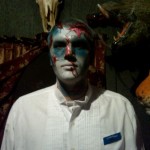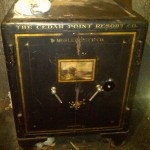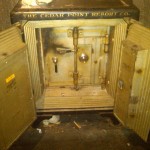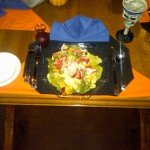
The Eppler Complex, located to the right, is a three story academic building that features gymnastics rooms, a basketball court, and many classrooms and office space
The Eppler Complex, located in the middle of campus near Olscamp Hall and the Bowen-Thompson Student Union, is home to the Tourism Leisure and Event Planning (TLEP) offices and advisers. It has a full-size basketball court, gymnastics rooms, an indoor track, and some weight lifting equipment. The building was originally two separate buildings that included a Men’s Gymnasium and a Women’s Gymnasium. These were built around 1927 and were not connected. Between 1979 and 1980, renovations were completed to connect the two buildings and completely form a new building, the Eppler Complex (BGSU, 2011). Seeing as it has not been renovated since 1979-1980, the building is relatively outdated and seems to have much of a defined function, especially since the Rec Center was built around the same time the building was undergoing renovations. Part of the planning process is the Program Statement which is a detailed description of the requirements to build a new facility or renovate an existing one. The top ten elements of my proposed Program Statement would be:
1.) Objectives: The main objective in the renovation of the facility would be to define the purpose of the building. The purpose would be a building would be to combine recreation and academia. There would be classrooms just outside the recreational facilities that still exist and the offices would be relocated.
2.) Basic Assumptions of the Facility: The facility would be used solely for the purpose of classroom instruction and learning within actual recreational facilities. The building is confusing right now with the mixture of offices, recreational facilities, classrooms, labs, and resource centers. The building needs to be a strict classroom and educational recreational facility.
3.) Factors Affecting Planning: The biggest factor that I would see that would affect planning is the size of the building. The renovation that would take place would take offices out of the building and leave rooms vacant. The building is a very large building, however, the size of the building also adds to the confusion of the building. I would tear down some walls and expand some of the classrooms into mini-lecture hall classrooms. If need be, the South and Center sections of the building would still be connected but the North end would be walled off from the building and made available for other departments or the remaining office space. This would not be the first option though.
4.) Explanation of Current and Proposed Programming: The building would still be open to rent the gymnasium and other recreational equipment on the weekends to all students. The primary focus of the building would be to create a recreational learning environment for those who have to take classes that include recreational activities. With the facilities being renovated as well, it would certainly serve as a secondary location for rented space outside of the Rec Center on campus.
5.) Space Needs and Allocation: The current building is very confusing with the long hallways north-south hallways and the maze-like hallways that run east-west. The renovated building would need to seek a solution to the confusing layout by re-evaluating the floor plan and wall structure to see if there is a way to tear down walls and make the hallways and classrooms easier to navigate. The classrooms need to be bigger and have varying classroom spaces. The current building has a few dozen rooms that all hold between 25-40 people and are in long rectangles that make the learning environment cramped and uncomfortable. Classroom space would definitely be a major concern for the renovation.
6.) Purpose and Use of Auxiliary Space: The auxiliary space would be used classroom learning objectives throughout the week and then be of use during the weekend for campus organization rentals. The auxiliary space would be newly renovated so it would be an attraction for students to want to rent out the space and could potentially attract outside sources for rental.
7.) Service Facilities: The renovated building would include newly renovated bathrooms and locker rooms for the gymnasium and areas near the classrooms. It would also include a front office that would be in charge of the building and the rental information. The office would not take up much space and would be more a “welcome” desk for any visitors that may have questions about the facility or renting equipment.
8.) Spatial Relationships: As mentioned earlier, the renovation would have the classrooms more centralized to the gymnasium and other recreational facilities within the building. the classrooms would be connected to the facilities and would require the soundproofing feature to be added so as to not disturb any classes. The classrooms would be bigger and would be shapely to help students focus and be more comfortable in the classroom setting.
9.) Environmental Necessities: The newly renovated building would include an updated lighting system, heating system, and water/sewage system to help ease the costs to the environment. Lowering the amount of energy used and the resources used to operate the building could have a significant impact on the environment and could help set the example for other buildings to start updating their energy conservation plans.
10.) Equipment and Furnishings: Virtually everything in the building is outdated or uncomfortable. The gymnasium does not need to be state of the art but the floor should be replaced, the lighting needs to be brighter, and the walls need to be renovated to be more acoustically pleasing. The classrooms need to be re-painted and the desks need to be replaced. Many of the desks are mismatched, broken, and highly uncomfortable. The chalkboards need to be replaced by dry-erase boards and the sporting equipment needs to be updated as well.
Program statements are extremely important to the development of buildings and facilities because it lays out the project’s purpose and what the expectations are for the development. They are meant to guide the planning process and give a general visualization of what the building will be like after it is completed. It is meant to be more of an outline and generalized statement then a fully-detailed plan and that allows for the flexibility of the master plan for the building.












